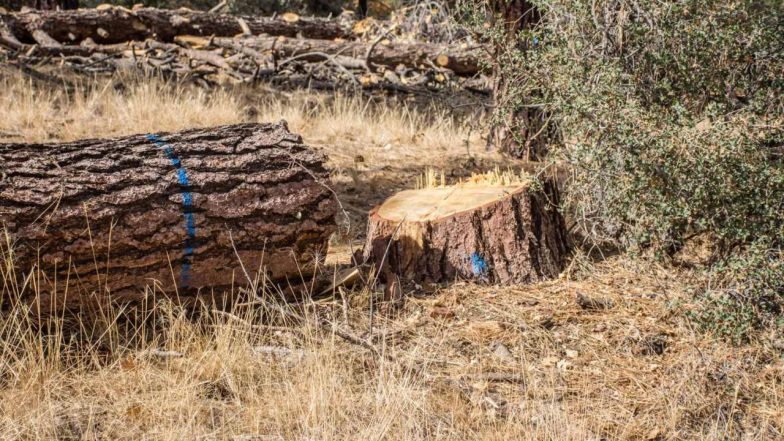Summary
Habitat loss and degradation are major threats to biodiversity, referring to the reduction or destruction of natural environments and the decline in their quality, respectively. This includes outright habitat loss, where natural areas are converted to other uses, and degradation, where habitats become less suitable for their native species. Fragmentation, the division of habitats into smaller, isolated patches, also contributes to these issues.
OnAir Post: Habitat Loss
About
Source: Gemini AI Overview
Key aspects of habitat loss and degradation
- Habitat LossThis occurs when natural areas are converted to other uses like agriculture, urban development, or infrastructure.
- Habitat DegradationThis involves a decline in the quality of a habitat, making it less suitable for native species.
- Habitat Fragmentation
This is the division of habitats into smaller, isolated patches, often by roads, development, or other barriers, hindering species movement and survival.
Causes of Habitat Loss and Degradation
- Land ConversionExpansion of agriculture, urban development, and infrastructure projects lead to the conversion of natural areas.
- PollutionIndustrial chemicals, pesticides, and other pollutants contaminate habitats, affecting water and soil quality.
- Over-exploitation of natural resourcesExcessive logging, fishing, and hunting can deplete resources and damage ecosystems.
- Climate ChangeRising sea levels, extreme weather events, and ocean acidification can alter habitats and displace species.
- Invasive SpeciesNon-native species can outcompete native species for resources and alter ecosystem structure.
Consequences of Habitat Loss and Degradation
- Biodiversity LossHabitat loss is a major driver of species extinction and decline.
- Ecosystem DisruptionChanges in habitat can disrupt ecological processes, affecting food webs and nutrient cycles.
- Reduced Ecosystem ServicesHabitats provide essential services like clean water, pollination, and climate regulation, which can be compromised by habitat loss and degradation.
- Increased Disease TransmissionHabitat loss can bring wildlife into closer contact with human populations, increasing the risk of disease transmission.
Addressing Habitat Loss and Degradation
- Sustainable Land Use PracticesImplementing sustainable agricultural practices, promoting urban green spaces, and careful planning of infrastructure development are crucial.
- Pollution ReductionControlling pollution from industrial and agricultural sources is essential.
- Restoration of Degraded HabitatsRehabilitating degraded areas through reforestation, wetland restoration, and other techniques can help recover habitat function.
- Combating Climate ChangeReducing greenhouse gas emissions and adapting to the impacts of climate change are vital for protecting habitats.
- Species ConservationProtecting endangered species and their habitats is crucial for maintaining biodiversity.
Problems/Challenges
Habitat loss, including destruction, fragmentation, and degradation, poses a significant threat to wildlife and biodiversity globally. The primary causes are human activities, driven by a growing population and unsustainable consumption patterns.
It’s important to recognize that these challenges are often interconnected and can exacerbate each other. For example, deforestation driven by agricultural expansion can contribute to climate change by releasing stored carbon, which in turn can lead to more frequent droughts and wildfires, further degrading and fragmenting habitats.
Addressing these challenges requires a comprehensive and multi-faceted approach involving sustainable land-use practices, conservation efforts, climate action, and addressing the root causes of overpopulation and unsustainable consumption patterns.
Initial Source for content: Gemini AI Overview 7/9/25
[Enter your questions, feedback & content (e.g. blog posts, Google Slide or Word docs, YouTube videos) on the key issues and challenges related to this post in the “Comment” section below. Post curators will review your comments & content and decide where and how to include it in this section.]
1. Habitat destruction
- Agriculture
Driven by global demand for food, vast areas of forests and other natural habitats are converted into farmland and pastureland. This is especially evident in regions like the Amazon rainforest, where cattle ranching accounts for a large percentage of deforestation. - Land Conversion for Development
Urbanization, infrastructure projects (like roads and housing developments), mining, and industrial activities continue to expand into wildlife habitats. - Logging
The unsustainable harvesting of timber and other forest products contributes significantly to forest loss, disrupting the delicate balance of forest ecosystems. - Trawling
This fishing technique involves dragging heavy nets across the seafloor, causing severe physical damage to marine habitats.
2. Habitat fragmentation
- Obstacles to Movement
Roads, railways, and other development projects create physical barriers within habitats, isolating populations and restricting access to resources like food, water, and mates. - Limited Resources
Fragmented habitats may not be large enough or connected enough to support species that require large territories or those that need to migrate. - Increased Edge Effects
Fragmentation increases the proportion of habitat edges, which are often characterized by altered environmental conditions and may favor invasive species or generalist species over native species. - Genetic Isolation and Decline
Fragmented populations may experience reduced genetic diversity and inbreeding due to isolation, making them less adaptable and more vulnerable to extinction.
3. Habitat degradation
- Pollution
Runoff from agriculture, urban areas, and industrial activities introduces harmful chemicals, pesticides, and other pollutants into air, water, and soil, compromising the health and functionality of ecosystems. - Invasive Species
Non-native species can outcompete native species for resources, prey on them, or introduce diseases, further disrupting ecosystems. - Disruption of Ecosystem Processes
Activities like altered fire regimes, water diversions (such as dams affecting rivers), or disruption of natural flood cycles can degrade habitats and make them unsuitable for native wildlife. - Climate Change
Rising temperatures, changes in precipitation patterns, sea-level rise, and more frequent extreme weather events are increasingly impacting habitats, forcing species to adapt, relocate, or face extinction. Climate change can also exacerbate other stressors, like land development pressures on coastal areas or vulnerability to erosion in logged forests.
Research/Innovations
Habitat loss, a major driver of biodiversity decline, is being tackled by a range of research and innovations.
These efforts, from high-tech tools to community-based initiatives, offer hope for mitigating and reversing habitat loss and protecting Earth’s biodiversity.
Initial Source for content: Gemini AI Overview 7/9/25
[Enter your questions, feedback & content (e.g. blog posts, Google Slide or Word docs, YouTube videos) on innovative research related to this post in the “Comment” section below. Post curators will review your comments & content and decide where and how to include it in this section.]
1. Nature-based conservation efforts
- Protected Areas
Establishing designated regions (national parks, wildlife reserves, marine sanctuaries) to limit or prohibit human activity and allow ecosystems to thrive naturally. - Wildlife Corridors
Creating or restoring habitat stretches to connect isolated populations and maintain genetic diversity. - Ecological Restoration
Restoring degraded areas (e.g., reforestation, wetland restoration) by planting native species, removing invasives, and fostering natural processes.
2. Technological advancements
- Remote Sensing and GIS
Using satellites, drones, and GIS software to monitor large areas, detect deforestation, track changes in vegetation health, and plan restoration projects. - AI and Machine Learning
Analyzing vast datasets to identify patterns in animal behavior, predict environmental changes, detect deforestation, and identify illegal logging. - Drone Technology
Monitoring wildlife, mapping habitat destruction, and dispersing seeds for reforestation. - Bioacoustics Monitoring
Analyzing soundscapes to assess the health and diversity of species in ecosystems, even remotely. - Environmental DNA (eDNA)
Detecting species presence in environmental samples (water, soil) to monitor elusive or endangered species without traditional capture methods. - Biotechnology
Exploring genetic engineering to create more resilient plants for restoration and to enhance genetic diversity in endangered species, while acknowledging ethical considerations.
3. Policy, sustainable practices and community engagement
- Sustainable Land Management
Practices like conservation agriculture, agroforestry, integrated pest management, and sustainable forest management reduce environmental impact, promote biodiversity, and enhance ecosystem services. - Community-Based Land Management
Engaging local communities in decision-making and implementation of sustainable land use practices, according to Wildlabs. - Citizen Science
Platforms and initiatives that empower the public to contribute to data collection, monitoring, and even restoration activities, fostering environmental stewardship. - International Cooperation
Agreements and policies, like the U.S. Lacey Act, to combat illegal wildlife and timber trade and promote conservation efforts globally.
Solutions/Projects
Habitat loss, driven primarily by human activities like development and unsustainable land use, is a major threat to biodiversity. However, a variety of organizations are actively involved in both current and future projects to address this challenge.
These efforts, involving governments, organizations, scientists, businesses, and individuals, are crucial for mitigating habitat loss and ensuring a sustainable future.
Initial Source for content: Gemini AI Overview 7/9/25
[Enter your questions, feedback & content (e.g. blog posts, Google Slide or Word docs, YouTube videos) on current and future projects implementing solutions to this post challenges in the “Comment” section below. Post curators will review your comments & content and decide where and how to include it in this section.]
Current Projects & Strategies
- Protected Areas and Conservation Programs
Establishing and managing reserves and parks to protect crucial habitats and biodiversity. The Amazon Rainforest, despite ongoing threats, includes protected regions that limit deforestation. - Habitat Restoration and Reforestation
Restoring degraded areas by replanting native trees and vegetation, or restoring wetlands to improve soil health, filter water, and provide habitat. - Addressing Specific Habitat Issues
- Marine Ecosystems
Initiatives like the NOAA Restoration Center support projects nationwide focused on rivers with sea-going fish, wetlands, coral reefs, and large bays. Examples include oyster reef restoration in North Carolina and Virginia. - Forests
Projects are working to secure the future of forests like the Tongass National Forest by ending old-growth logging and promoting sustainable opportunities like carbon markets. - Coral Reefs
Efforts like the Mission: Iconic Reefs in the Florida Keys are restoring degraded coral reef habitat through coral propagation and outplanting. - Endangered Species
Conservation efforts such as forest restoration in Spain are helping to increase the Iberian Lynx population by creating suitable habitats and improving prey bases.
- Marine Ecosystems
- Sustainable Practices
Promoting sustainable land-use practices like agroforestry, which integrates trees into agricultural landscapes, is essential.
Future Projects & Innovations
- Technology-Driven Solutions
- Drones
Used for monitoring restoration progress, identifying areas of concern, and precise seed dispersal. - Artificial Intelligence (AI)
Analyzing datasets to identify areas needing restoration, predict invasive species spread, and optimize restoration strategies. - Remote Sensing and GIS
Mapping and monitoring ecosystems, identifying restoration opportunities, and tracking progress. - Biotechnology
Developing climate-resilient crops, controlling invasive species, and potentially cloning endangered species, according to LinkedIn.
- Drones
- Policy and Finance
- Payment for Ecosystem Services (PES)
Providing financial incentives for landowners to restore and maintain ecosystems. - Sustainable Finance
Leveraging quality carbon credits, sustainable timber markets, and eco-tourism to create financial incentives for restoration.
- Payment for Ecosystem Services (PES)
- Community Involvement
Projects like the “Habitat Heroes” program in Norfolk, VA, encourage individuals to transform their yards into native habitats. - Addressing Climate Change
Initiatives like the National Wildlife Federation’s partnership with NOAA are focusing on climate-smart coastal restoration in the Great Lakes region.


